
Heart disease, kidney failure, respiratory problems and painful joints are all much more common in dogs who are overweight.
Unlike humans, however, dogs rarely have trouble finding the motivation to be more active. In fact, most dogs are grateful for the chance to exercise with their pack leader.
The following tips will get your pooch fit and healthy in no time and will provide hours of fun and entertainment for both of you.
1. Get a Treadmill
Ensuring your dog gets plenty of exercise is part of your responsibility as a pet owner. Simply letting your dog roam the garden or only taking him out for a few moments to go to the bathroom doesn’t provide the exercise your dog needs for a healthy heart, joints and digestive system.
Unfortunately, many dog owners suffer from poor health and limited mobility themselves, and many others live in a region where two feet of snow on the ground is normal in the winter, or where the summer heat is more dangerous for a dog than the lack of exercise.
In this case, a dog treadmill is the ideal solution. While it’s possible to exercise your dog on a treadmill designed for humans, it’s not as safe as one designed specifically for the lower weight and different speed requirements of dogs.
Introduce your dog to the treadmill slowly. Put him on a leash and let him sniff around it while it’s stationary. Guide him to stand on the treadmill, and give him a treat while he’s on it so he’ll develop a positive association with it.
Once your dog is familiar with standing on the treadmill, turn it on to the slowest setting. Make sure your dog is on a leash for the first exercise session. It won’t be long before your dog is hopping on the stationary treadmill, looking to you to turn it on.
2. Agility Training
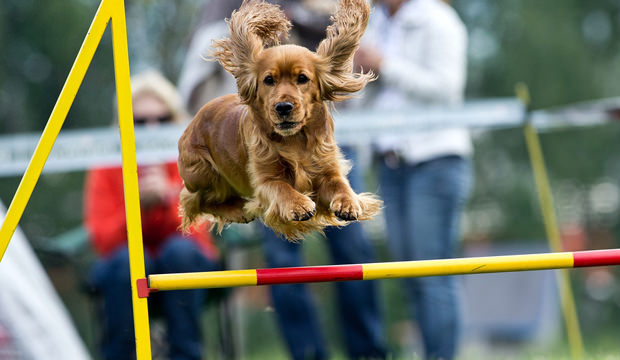
Complete it with slalom poles made of PVC, a plastic collapsible tunnel, a seesaw made from a long board and PVC pipe, a tire jump made with an old tire hanging from a tree, and a picnic table bench for a balance beam.
You can also purchase agility equipment from larger pet stores. Before you begin agility training, make sure your dog understands basic commands like “sit,” “stay,” “lie down” and “come.” If your dog is untrained for the most part, put him on a leash and guide him through the obstacles.
Have healthy dog treats on hand to reward your pet for the successful completion of each obstacle. Once your dog is familiar with how to proceed through the obstacles, you can begin working on speed and agility, along with training your dog to understand commands like “through,” “over,” “under,” “up” and “down.”
If you don’t have a garden, take your dog to a children’s playground either early in the morning or late in the evening, when it will most likely be deserted. Introduce your dog to the roundabout, slides, seesaw and playhouse. Be sure to use low-fat treats during training, such as small pieces of fruit and vegetables.
3. Go For A Bike Ride Together
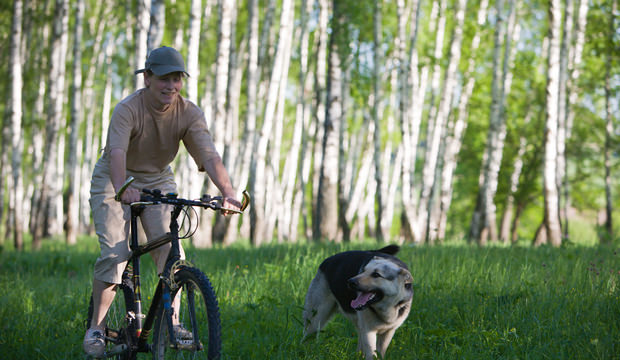
A great alternative is to go on a bike ride with your pet. Bicycling is an easy, fun and low-impact way to exercise for you, and your dog can run alongside you as you cycle.
However, there are a number of safety precautions you should take before going on a ride with your dog.
First, invest in a leash designed specifically for bike riding. This ensures that you’re not pulled off balance and that the leash doesn’t detach from your hand in the event of a spill. Secondly, outfit your dog with a harness to take the strain of the leash off of his neck.
The last essential item is a collapsible water bowl and plenty of water to protect your dog from the dangers of dehydration.
If your dog isn’t familiar with your bicycle, start by letting him sniff the bike. When he seems comfortable with the equipment, ride around in a small area, keeping your dog next to you.
Once your dog is able to stay beside you without distraction, take a short ride around a park or a quiet neighborhood, and gradually increase the amount of time you ride.
Always ride on a trail or in a quiet residential neighborhood to avoid the dangers of traffic, just in case your dog bolts or you lose control of the bicycle.
4. Treat Balls
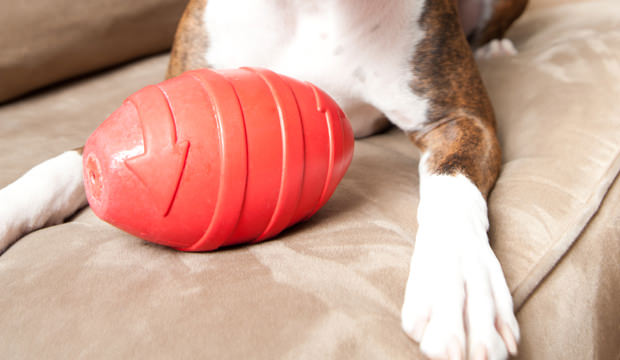
Treat balls are interactive and (mostly) indestructible toys made of hard rubber, containing at least one deep cavity in which you can hide treats or stuff peanut butter.
Treat balls are a great way to keep your dog occupied and active for hours as he tries to manipulate and chew on the ball to get to the treats hidden inside.
If your dog is overweight, forego the peanut butter and fattening bacon-flavored treats and stuff the ball with a handful of tasty, healthy treats instead, such as small pieces of apple, carrot or sweet corn.
Pet stores also sell treats that have less fat and fewer calories than the treats available at the local grocery store.
To make this mental workout a physical one as well, play catch with the treat ball so that your dog must run after it. You can also try hiding it in the garden to help your dog exercise his sense of smell and his hunting abilities.
You can purchase treat balls online or from any pet store, along with healthy treats to put inside.
5. Swimming

Larger dogs and breeds with a high incidence of joint problems can benefit greatly from swimming, as it strengthens and tones muscles to help prevent injuries related to running and playing on land.
If your dog is overweight or recovering from illness or surgery, swimming is the ideal way to exercise him, as it’s a very low-impact way to burn calories and get the cardiovascular workout he needs for good health. In fact, for dogs, the benefits of a one-minute swim are equal to those of a four-minute run.
Swimming provides more than just physical benefits for your dog. It also helps your dog relax, reducing stress and anxiety that may result in fearfulness or aggression.
If you are lucky enough to live close to the sea or a lake, make a commitment to take your dog swimming as often as possible during the hot summer months.
Otherwise, look for any businesses close to you that offer hydrotherapy for dogs.
Many boarding kennels, dog groomers, day care centres and veterinarians now offer hydrotherapy for animals.
If you have a small dog, purchase a child’s paddling pool and set it up in your garden or garage. Always supervise your dog whenever he is in the water.
6. Socialization Classes
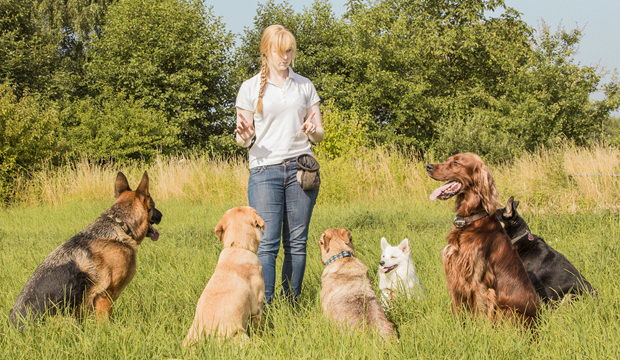
Socialization classes also provide you with the opportunity to meet other like-minded dog owners as your pets frolic and chase.
While dog parks offer a place for your pet to run and play with other dogs, socialization classes ensure that all of the dogs who participate are up to date on shots, and the expert facilitators are trained in dealing with more aggressive dogs and reducing the potential for fights.
To learn about dog socialization classes in your area, consult with your veterinarian or call your local pet store.
If you cannot find a suitable doggy socialization class, why not start your own? If you know other dog owners, set up a weekly play date for your dogs, or place an ad in the local paper or on a bulletin board to find other interested pet owners.
Keep the dogs on a leash when they meet for the first time. Let them sniff each other, and look for signs of fear or aggression. When the dogs are calm and ready to go play, let them off the leash, and sit back and enjoy the day.
7. Fat Camp
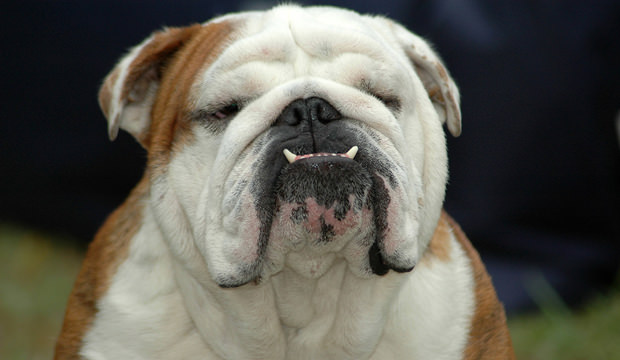
Just like in humans, obesity in dogs can lead to high blood pressure, arthritis, diabetes, and kidney and respiratory.
Getting your dog back down to his ideal weight is essential for longevity and a high quality of life.
Fat camp is becoming increasingly popular for dogs, and it can help your dog lose weight in a safe, healthy and permanent way. Fat camp centres are opening up all over the world due to the high demand for the services, which include obedience lessons and nutritional advice, as well as physical exercise such as swimming, running on the treadmill and exploring nature trails on the facility premises.
Some centres will accommodate both you and your dog, while others require you to leave your dog in their care for a set amount of time.
Fat camp is also a good option for dog owners who do not have the time or physical ability to exercise their dog regularly. Make sure you do some thorough research on any training centres that require you to leave your dog alone, and go online and read any reviews before signing up.
8. Hold Food Tasting Sessions
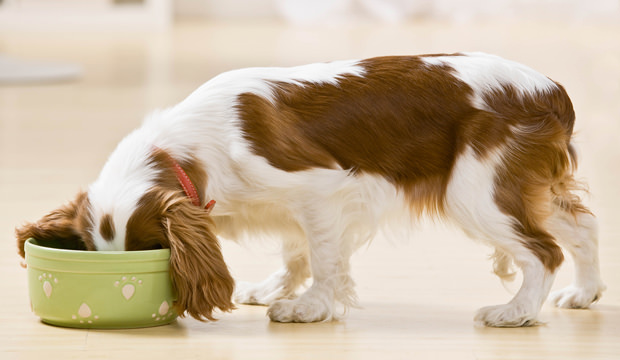
Start by swapping out your dog’s food for a brand that’s designed to help your dog lose weight. Try out a few different flavours and brands, and let your dog decide which he likes best.
To make your dog’s food tastier, and to give him a few extra doses of essential nutrients, try adding in healthy human food that is safe for dogs.
Tuna, salmon and other fish are high in omega-3 fatty acid, which keeps your pet’s coat healthy and shiny and provides extra protein and vitamins.
Turkey and chicken are lean meats that will provide your dog with a healthy dose protein without the extra fat and calories of red meat.
Scrambled eggs are high in protein, riboflavin and selenium and provide texture and moisture to your dog’s dry food.
Plain, cooked oatmeal is high in fiber, and can help regulate the digestive system of older dogs.
Seeded, cored and chopped-up apples are packed with essential vitamins and antioxidants that will help keep your dog young and healthy. As an added benefit, apples are helpful for cleaning your dog’s teeth and freshening his breath.
Experiment with different combinations of human food and dog food to find the best fit for your pet.
9. Piggy in the Middle
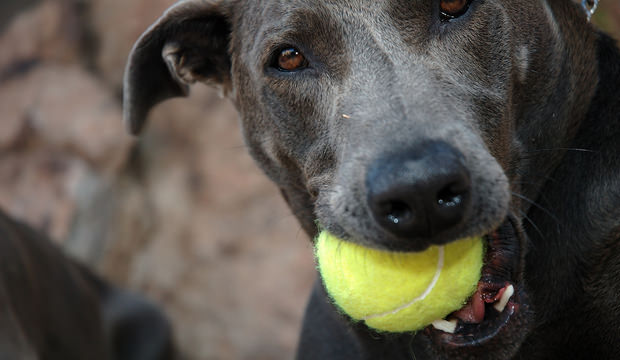
Even if you go on runs with your dog, chances are, he’s running much slower than he’d prefer.
Piggy in the middle is the perfect solution for giving your dog the opportunity to run at his full speed.
You’ll need two humans for this fun game, which provides a good cardiovascular workout to lower his weight and improve his overall health.
Take your dog to a local park, or play in the garden if you have space. Stand about 40 metres away from your friend. Throw your dog’s favourite ball to your buddy and let your dog tear after it at full speed.
Instead of giving the ball to your dog, your friend will throw the ball back to you. Of course, your dog will follow the ball, and a few rounds of this game will not only tire him out, but will also burn far more calories than a long walk alone can.
Consider using a treat ball for this game, which will provide your pet with a fun, delicious treat when the game is over and your dog is allowed to catch the ball.
10. Doga
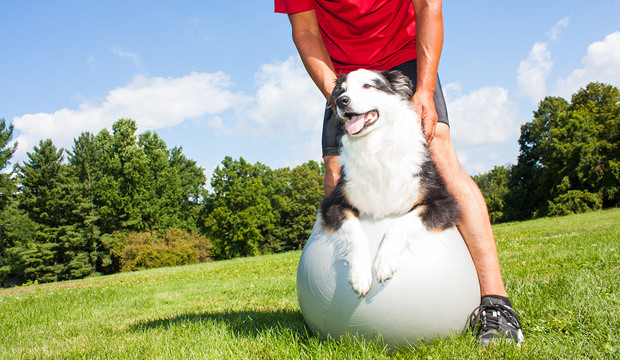
Doga has slowly begun to spread to other parts of the world, and most big cities now offer classes.
Doga is especially beneficial for dogs with arthritis, breeds with a dispensation for joint problems and those with old injuries that may still cause pain and discomfort.
A combination of massage, stretching and meditation, Doga involves the pet owner, who helps manipulate the dog into poses that stretch and strengthen muscles. You will also learn how to massage your dog to help improve the function of his heart and digestive system, as well as reduce stress and anxiety.
Doga can help you bond with your dog. Dogs are pack animals, and a strong connection to you is vital for your pet’s overall wellbeing. Doga is the perfect opportunity to connect with your dog on a spiritual level.
If you cannot find a Doga class near you, there are many videos available on YouTube of Doga classes that you can conduct from the comfort of your own home. Whether or not your dog will enjoy it is another matter.
11. Personal Trainer
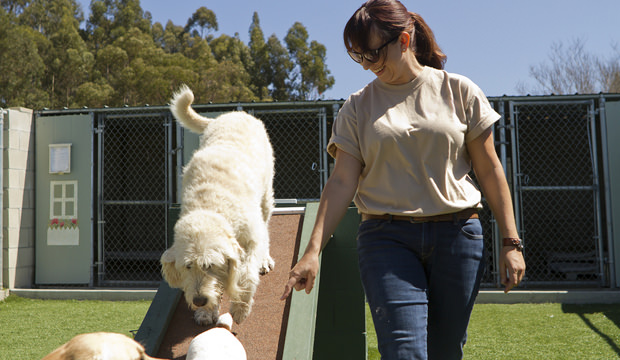
If exercise and diet don’t seem to be doing the trick and your dog is still overweight and lethargic, it may be time to call in a personal trainer. Doggy fitness trainers are different from obedience trainers.
Fitness trainers work with you and your dog to come up with the most effective, personalized plan to help your pet lose weight and live a quality, healthy life.
Your trainer will take into consideration your dog’s breed, energy level, personality and food preferences when coming up with a diet and fitness plan to help your dog lose weight effectively and permanently. The trainer will also take into consideration your own lifestyle, energy level and fitness abilities to find the best plan for you and your dog
Some trainers require you to come to them, while others will conduct the sessions in your home. You may need only one session, or you may want to continue working with a trainer for advice and support until your dog has reached his ideal weight.
To find a trainer in your area, consult with your veterinarian or visit your local pet store.

Make sure to dry out your dog’s ears after swimming, especially if you have a floppy eared dog! Moisture trapped inside a dog’s ears will lead to a nasty bout of ear infections that can be incredibly difficult to get rid of. It CAN happen in cropped/upright eared dogs too but it happens much less often because there is so much more air flow and the ears dry much more easily. Be careful when adding “extras” to a picky dog’s food unless you are prepared to add something to their food EVERY time you feed them. It is VERY easy… Read more »